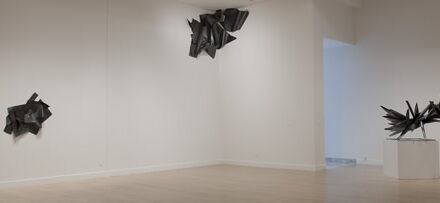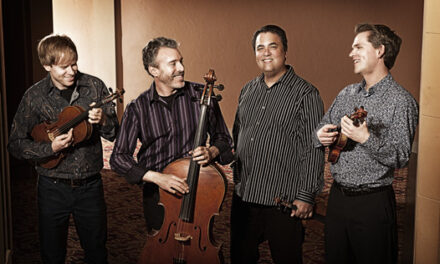The nineteenth century found the juxtaposition of the search for deep philosophical and religious truths with popular pantomime tomfoolery in Mozart’s Die Zauberflöte (The Magic Flute) too much to take. It came to be recognized as one of the composer’s greatest operas in the early twentieth century revivals. Even so, many scholars have felt compelled to apologize for what Edward J. Dent, in Mozart’s Operas, called one of the worst possible examples of the libretto as a form of literature. Opera Carolina’s brilliant staging, strong vocal cast, excellent pit orchestra, and not least, Jun Kaneko’s colorful and lively projections make the strongest possible case for the opera. Conductor James Meena used his own adaptation of the widely used Ruth and Thomas Martin translation of the original German singspiel. The clear enunciation and projection of the English words by the entire cast made the supertitles much less necessary.
The sellout opening night audience in Belk Theater heard a remarkably even and strong vocal cast. The lovers were an ideal pairing. Soprano Yunah Lee perfectly conveyed Pamina’s naïve innocence and sang with an even, warm tone. As Prince Tamino, tenor Shawn Mathey sang with a burnished and robust sound while portraying a wide variety of emotions.
The dueling powers were even more strongly matched and both brought stage presence in spades to their roles! Because of the libretto’s poor continuity, the Queen of the Night first appears to be a good, wronged mother wanting the return of her daughter but she abruptly becomes a vengeful harpy before the end of Act I. Soprano Maria Aleida delivered the coloratura of the Queen with laser-like precision, every note clean and pure. I have never heard a better live performance of the part in the State. The same was true of the magnificent, low, sustained bass notes Tom McNichols’ magnanimous Sarastro, leader of the Kingdom of the Sun. His phrasing and control of shading were wonderful. These were the kinds of performances of which opera lovers dream!
The comic pair of lovers was a good pairing and well matched. Baritone Kyle Pfortmiller has a golden and beautifully balanced voice, and he handled the extensive spoken dialogue with a real flair. As Papagena, soprano Kathryn Frady’s voice is limited to portraying an old crone until nearly the end of the opera but her “real” voice found no quality wanting.
Melodramatic villainy could not hide the fine tenor quality of Julius Ahn as the blackamoor Monostatos, Sarastro’s work gang leader. The Queen of the Night’s argumentative Three Ladies were an evenly matched vocal set. Soprano Diane McEwen-Martin was the First Lady, soprano Melinda Whittington was the Second Lady, and mezzo-soprano Daidree Tofano was the Third Lady. The latter’s initial slightly lesser projection quickly disappeared over the course of the opera. Opera Carolina did not risk having a boy singer’s voice crack and cast the role of the Three Boys with women who blended well in their unison singing. Soprano Alexandra Engle sang the First Boy, soprano Margaret Tyler sang the Second Boy, and mezzo-soprano Erica Powell sang the Third Boy. The firm resonant role of the First Speaker was sung by John Fortson with apt gravitas. He brought these same qualities as he doubled the roles of First Priest and Second Man in Armor. Tenor Noah Rice brought a nice comic touch to the role of the Second Priest charged with guiding Paganeno to “Enlightenment” and proper gravity to the role of First Man in Armor.
James Meena led a stylish and vital performance and secured solid playing from the members of the Charlotte Symphony in the pit. There were some superb sounds from the French horns and fine support from the woodwinds. The excellent Opera Carolina Chorus had been well prepared. Stage Director Garnett Bruce arranged and blocked his cast for the most dramatic effect and hid the loose ends of the libretto as much as possible. The lighting design by Michael Baumgarten was effective.
The essence of this production was second staging using the set, costume, prop and projection designs of noted ceramic artist and sculptor Jun Kaneko. The production had its world premiere in June 2012 at the San Francisco Opera and this was its second outing by members of the commissioning consortium. A major aspect is the use of more than 700 projected animations. Colorful straight and curved lines and geometric forms are “drawn” behind and about the cast during the performance. Occasionally, such as during Pamina’s aria of despair, these seemed over active, drawing attention away from the focus of the drama. The bright colors certainly livened up things. The dragon, sadly only two-headed not three, was handled by black-dressed puppeteers much like in a Japanese Buraku play. They changed the limited stage props too.
Papageno’s birdcage was not filled with birds but polka dotted eggs of various sizes. The animals charmed by Tamino’s flute looked like gigantic carved birds a child might play with. I have no idea how they were able to see how to carry out their choreography! I loved the costumes of the two Men in Armor; they were a prickly pair looking like robots out of a 30s Buck Roger’s serial covered with a mace’s sharp spikes!
Kaneko’s designs will be used later by the National Opera, Washington, D.C., Opera Omaha, and Lyric Opera of Kansas City.
With an outstanding cast, a colorful and fantastical staging by Jun Kaneko, and being sung in English, Opera Carolina’s Die Zauberflöte is a memorable night at the opera not to be missed. Sunday matinee attendees ought to consider attending the Opera Postlude instead of wasting gas and time trying to get out of the parking deck. Director Meena excels with these informal presentations which can feature cast members, composers, and others of interest in a free give-and-take with opera lovers.












